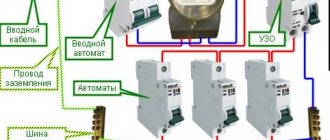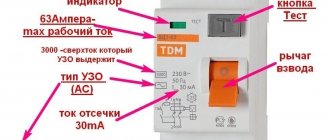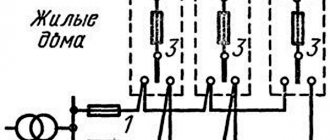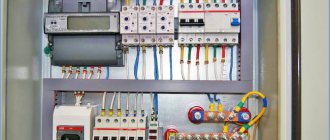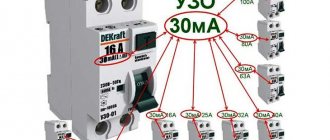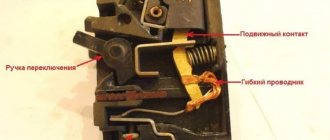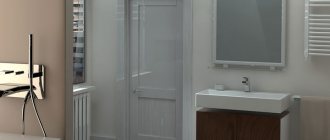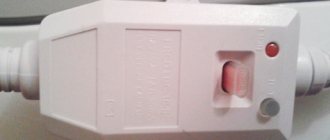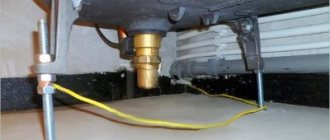Purpose
An RCD is an electrical device specially designed to cut off the power to electrical appliances during leakage currents. Leakage currents occur due to minor violations of the insulation of current-carrying phase conductors. If the insulation is broken, current begins to “flow” through the metal casings of electrical appliances or conductive structures of an apartment or house. Leakage current is also called differential current.
Since the leakage current is small in value, circuit breakers installed in the electrical network do not operate on it and do not turn off the power supply. Circuit breakers turn off the electrical network in the event of a short circuit in the network (touching a phase and neutral wire or two phase wires) or overload. Circuit breakers do not respond to small leakage currents.
Leakage current is a dangerous electrical fault for humans. For example, if you touch a conductor through which a current of 0.3 milliamps flows, you will feel an ant bite; with a current of 15 milliamps, it will be difficult to tear yourself away from the conductor, but it is still safe. This cannot be said about a current of 40 milliamps. When you “touch” such a leakage current, you are guaranteed to experience body and diaphragm convulsions, which is undoubtedly very life-threatening. RCDs are designed to protect people from leakage currents. Such devices must have a cut-off current of no more than 30 mA.
To protect the premises from fire, a general RCD is installed to protect people from leakage currents, with a cut-off current of 100 mA or 300 mA.
How to choose an RCD for a private house
Probably everyone knows about the main dangers of electricity. This includes various short circuits, leakage currents, and overloads. All this can lead to negative “and often irreparable” consequences.
In order to prevent them, residual current devices are installed on circuit breakers in switchboards.
However, for the normal functioning of the system, you first need to know how to choose the RCD correctly, that is, specifically for your machines. More on this and more below.
What can happen if you make the wrong choice?
If you purchased the first device you came across, most likely it may not function properly. Here's how it could turn out:
- the device can turn off the electricity during minor leaks that are not dangerous to the system, but can happen frequently;
- if you make the wrong choice in the other direction, the RCD will not work during a serious leak, which can result in an electric shock;
- you can purchase a device and put it on a shelf, since in many homes you can find aluminum wiring, and many current models are designed for copper.
Principle of operation
How does an RCD save us and our devices? It's actually simple. Three coils are hidden under the body. One of them is connected to the phase, the second to the neutral conductor. As currents flow through the coils, they generate magnetic fields.
Since their lines of force are oppositely directed, in a normal situation they are destroyed by each other. If the current is even stronger in phase, even at zero, a residual field is obtained, due to which a current appears in the next, third coil.
And then the device disconnects the house from electricity.
RCD selection
How to choose the right device for your shield? There are many criteria to consider here. If you discard at least one of them “especially if it is important,” you can get the consequences described above. What should you pay attention to? Now we will tell you about this.
Rated load current
Any machine and RCD are designed for a certain rated current. Selecting a device based on this criterion is not difficult: you just need to look at the value on the machine and select the protection with the highest one. So, for a 16 A machine you need a 25 A RCD. It is not worth installing both devices with the same value: in this case, the shutdown will not happen immediately, and during this time anything can happen.
Differential current
Here we need to return briefly to the previous point. The fact is that if you set a device with greater sensitivity to a high rated current, it can often trigger. But there is one “but” here. The fact is that for your home you cannot choose an RCD with a leakage current setting greater than 30 mA, since a higher voltage can be harmful to health.
Therefore, the differential indicator should be greater than the nominal value only if it does not exceed 30 mA. For bathrooms, the value should be no more than 10 mA, since there is high humidity.
But what about devices with high value, you ask. The fact is that they are intended not only to protect people and household appliances. If the setting is higher than 30 mA “for example, 100”, then such devices are intended to prevent fires due to leakage “for example, in production”.
Type of protective device
We figured out how to choose an RCD and an automatic machine based on power. Now let's find out how products are divided by type. True, it is also divided into two subspecies based on two characteristics. One of them is a type of leakage current. According to it, RCDs are:
- for alternating current “type “AC”. Such devices are the cheapest. Previously, they could be chosen by household consumers, but today it is better not to pay attention to such a product, since many appliances “for example, a washing machine or computer” do not use alternating current;
- for alternating and constantly pulsating currents “type “A”. This RCD is ideal for houses and apartments. Yes, they are more expensive than the previous ones, but they are no longer useless;
- for alternating, constantly pulsating and rectified currents “type “B”. It can also be used at home, but there is no reason: rectified current is not used in apartments, that is, there is no need to protect against its leakage, and the cost of such protection will amount to a tidy sum. This type is installed, again, in production, where all types of currents are used.
We're done with the first sign. Let's move on to the second - response time. As a rule, for apartments they choose conventional RCDs, which turn off the home network after 20-40 ms. In addition to them, there are two more types with delayed shutdown:
- type "S". Triggers after 150-500 ms, used as input;
- type "G". “Switches off” the house after 60-80 ms, placed on a separate device.
Why is such an RCD needed? After all, during this time you can get an electric shock! The fact is that a conventional device may fail and not work at all. Therefore, they are placed on a certain group of machines. If they don’t work, after some time the usual “comes into play.”
Design
This feature is also important. Moreover, it is easy to be deceived by choosing what seems to be the best. However, if you know the nuances, there is nothing complicated here.
So, according to the design of RCDs there are:
- electromechanical. They consist only of a differential transformer and a relay, a disconnecting device;
- electronic. There is also an amplifier here that increases the current power in that third coil. The fact is that to turn it off you just need the presence of excess voltage. If the current is weak, the transformer may not work, so you need to install a more powerful type. You can use a simpler transformer with an amplifier, which is naturally more profitable. Therefore, electronic RCDs are cheaper and also compact.
This is where many begin to think that the second device is better, and it’s worth choosing it. And they are wrong. Why? The fact is that the amplifier also requires power, so it is connected to the serviced circuit. Now imagine that somewhere above the protection the zero has broken.
The sockets do not work, nor does the electronic RCD: the amplifier does not receive power, the transformer cannot operate due to low voltage in the coil. If the user sees a bare wire, he can touch it.
But the phase is intact, so you can be sure that you will get an electric shock.
You don’t even have to touch the wires, because there may be some housing under voltage. But the electromechanical RCD will work in such a situation, because here the transformer is selected correctly, since there is nothing to increase the power here. Therefore, if you have extra money and space in the shield, it is better to choose this one.
Residents of private sectors
How to choose a protective device for private home owners? The principles here are the same, only there are a few additional ones. Firstly, only one phase is carried out in an apartment, but three can be thrown in a private house. In this case, you need to choose a three-phase model.
Installation standards
According to Russian standards, an RCD with a shutdown current of no more than 30 mA is installed for residential premises. The response time of the RCD, that is, the time from the appearance of leakage currents to the shutdown of the electrical circuit, should be in the range of 0.1-0.3 seconds; this shutdown time is sufficient to protect a person from death. But don’t think that with an RCD installed, you won’t feel the electric shock at all. There will be an electric shock, but the device must turn off the current in time and save your life.
I note that the same standards apply in Europe. In America, according to their National Electrical Code standard, RCDs installed in residential premises must have an operating current of 5 mA
Note: The serviceability of the device must be checked before installing the RCD, after installing the RCD and every six months using the “Test” button on the case. If, when you press the “Test” button, the RCD works, that is, it turns off the network, then it is fully operational. If it doesn't work, it needs to be replaced.
Introductory machine: which one to choose for an apartment or private house
Internal electrical wiring includes various elements, each of which solves its own problem. One of the most important is the incoming automatic switching device, installed in front of the meter, which allows you to automatically de-energize the line in an emergency, as well as if wiring repairs are necessary.
In accordance with the requirements of the PUE, the installation of this device is mandatory, and the operation of wiring not equipped with it is not allowed. In this article we will talk about what an input circuit breaker is, how to choose this device and how input circuit breakers are calculated for a private house or apartment.
As mentioned above, input circuit breakers allow you to turn off the power to the electrical wiring if it needs to be repaired or upgraded.
The input machine is usually not installed in the apartment; its installation is most often done on the landing. In one-story buildings they are installed outside the house, on the street.
Externally, the input circuit breaker is practically indistinguishable from the protective devices mounted inside distribution boards, but the rated current for which it is designed is much higher.
note
Protective devices installed at the input can have from two to four poles. The number of them in the selected machine depends on the power supply mechanism, which was installed on site.
Sometimes a simple protective circuit breaker with a high current rating is placed at the input in front of the electric meter. Installation of this device does not provide reliable protection for the wiring, since when there is a loss of power, the phase line breaks, but the neutral conductor is still in contact with the electricity supply device.
What is the difference between an automatic protective switch and an input circuit breaker? From a technical point of view, nothing. This is a device designed to automatically shut down electrical networks in case of overload and short circuit.
The only difference is in the purpose and connection diagram.
READ MORE: Electrical wire colors, typical markings, analysis of nuances
If a conventional (group) machine operates within one or several lines, then the input device is responsible for connecting (disconnecting) the entire facility, be it an industrial enterprise or an apartment (private house).
Externally, the input circuit breaker looks like a regular switch.
It can be 1, 2, 3 or even 4 pole, depending on your facility's power supply.
The compact case contains the switching mechanism: two contacts, movable and fixed. When the cocking handle is moved to the working position, the contacts close and are mechanically fixed in the on state.
The circuit through which electric current flows includes two protective devices in series. One is triggered when the set threshold for temperature and current is exceeded (bimetallic plate), the second opens the contacts in the event of a short circuit, or rather, when the current value is significantly exceeded (electromagnetic release).
If the current gradually exceeds the permissible value (indicated on the marking of the machine), the plate heats up and mechanically opens the contacts. When a short circuit occurs, the current increases like an avalanche and activates the electromagnetic release. For multi-pole circuit breakers, it is enough to exceed the parameters on at least one line. The entire package of contacts will be disabled.
In all cases of protection activation, after the danger disappears, the circuit breaker does not return to its original state. A person is required to turn it on.
We already know that all the electrical current to power the object will flow through this switch. According to Ohm's law, it is clear that the load must be summed up based on all consumers in the house (apartment). Calculating this value is quite simple.
Of course, you can turn on the boiler, electric oven, air conditioner and iron at the same time. But such a “celebration of life” will require powerful electrical wiring. And the technical conditions for such input power will cost significantly more. For energy supply organizations, tariffs for coordinating connections grow linearly depending on the number of kilowatts.
For a typical apartment, we can assume the simultaneous operation of a refrigerator, TV, computer, and air conditioner. In addition to them, it is permissible to turn on one of the powerful appliances: a boiler, an oven or an iron. That is, the total power of electrical appliances will not exceed 3 kW. We don’t take lighting into account; today, every home has energy-saving lamps.
Usually, for a power reserve (force majeure circumstances are possible), 20–30% is added to the calculations. If you forget to turn off the boiler and start using the iron while the air conditioner is running, you won’t have to run to the electrical panel to restore the power supply. It turns out: 4 kW divided by 220 V (according to Ohm’s law), current consumption 18 A. The nearest circuit breaker is rated 20 A.
The marking is in the product passport, and always on the body.
When selecting a device more accurately, especially when used in conjunction with a non-standard load (motors or other loads with significant starting currents), it is necessary to make a choice not only by the rated current, but also by the time-current characteristic.
For example, the input circuit breaker shown below in the picture has a rated current of 16A and a characteristic of type “C” (type “C” is well suited for the usual standard load - our apartments).
We will tell you more about the time-current characteristic below.
Advice
We are not interested in higher currents, this exceeds the power of 15 kW. No one will approve such a connection to your apartment. Typically, residential input is limited to automatic machines with an operating window of about 32 A.
For a private home, the figures may be higher. The calculation takes into account the increased living space, the presence of outbuildings with power supply, a garage, a workshop, and powerful power tools. An input circuit breaker for supplying power to a private house usually has an operating current of 50 A or 63 A.
Where is it necessary to install an RCD in the electrics of an apartment and house?
According to our regulatory documents, the RCD is an additional protection device. (PUE ed. 7, clause 1.7.50; clause 1.7.156).
Optional does not mean optional.
Installation of RCDs is carried out in all groups of the electrical circuit in which plug sockets are installed. The rated shutdown current of the device should be no more than 30 milliamps. At least one general Protective Disconnection Device for the entire apartment (house) must be installed.
If you have an electrical network with many power supply groups, installing an RCD for each group together with a common RCD will only improve the safety of the living space. It is allowed to install one RCD on several separate power supply groups, provided that separate circuit breakers are installed on each group.
In damp areas of an apartment or house where sockets are installed (bathrooms, kitchens), as well as in separate electrical lines supplying household appliances that work directly with water (washing machine, dishwasher), you need to install an RCD with a cut-off current of 10 mA.
You should not install RCDs in electrical networks that directly supply household appliances, such as air conditioners. Such devices have an internal protection system. The device for such devices will most likely trigger falsely.
Installation of RCDs in 4-wire three-phase electrical networks (TN-C diagram). About grounding systems, read a separate article: Grounding systems TN, TT, TN-C, TN-S, TN-CS and IT.
Connection diagrams for RCD with switch
Protective equipment must be connected using two cables. The first will carry the load current, the second will be directed to the external circuit from the consumers. In order not to think about installing an RCD before or after the machine, you should use popular schemes.
For several groups of difavtomats - one RCD
Clause 7.1.79 of the PUE allows for the protection of several lines using an RCD. The device needs to be placed on top, then the switches on the consumer groups. In case of short circuits, the current passes through the RCD to the group circuit breaker, then to the power cable and to the consumer. If the rating of the devices is selected correctly, none of them will be damaged.
The advantages of implementing the scheme include saving money and space in the distribution panel. The downside of the connection is that all groups are disconnected after the RCD is triggered.
Installation of RCD to the machine
The scheme provides for installation in the following sequence:
- Safety shutdown device.
- Difavtomat.
- Power cord.
- Consumer.
If there is damage, the short circuit current passes through the RCD until the circuit breaker stops.
RCD after the machine
Assembly of the system is carried out according to the principle;
- switch - two-pole or feeder;
- counter;
- RCD;
- machines depending on the number of lines.
This option is correct, since it is easy to understand how to turn off the machine and apply input to its terminals. Despite the fact that RCDs break more often, they are easier to replace.
At the moment of a short circuit, the current will pass from the switch to the RCD, then to the power wire, then to the consumer. The switch stops and the protective device remains intact.
To prevent overload, a second automatic circuit breaker can be installed between the meter and the RCD.
Connecting an RCD to a group of machines
A similar circuit is assembled in a three-phase switchboard, where the following are located:
- 3 three-phase difavtomat;
- three-phase RCD;
- 2 single-phase RCDs;
- 4 single-phase single-pole circuit breakers.
From the first input circuit breaker, the voltage will go to the second three-phase circuit through the upper terminals. From the same device, one phase will go to a single-phase RCD, the second to the next one.
Single-phase protection devices have two poles, difautomatic devices have one. In order for the system to work without failures, it is necessary not to connect the working zero after it. For this reason, a zero bus must be installed after each protective device.
If there are two-pole circuit breakers, a separate zero bus is not installed. When two zeros are combined, a false positive may occur.
The first single-pole RCD is connected to differential circuit breakers No. 1 and No. 3, the second - to No. 2 and No. 4. The load is applied to the lower terminals.
The grounding bus is common, but it must be installed separately. Three phases with a working zero are connected to the input device. It is connected to the common zero, and then diverted to all RCDs. After device No. 1 it goes to a three-phase load, after the remaining single-phase loads - to each bus.
The wire into PEN and PE is not separated - ground, zero and 3 phases go to the shield.
Selecting an RCD for human protection from leakage currents
The RCD has two main characteristics.
- Rated load current (in amperes)
- Rated cut-off current, also known as differential current (in milliamps).
RCD load current
The RCD must be installed in the electrical circuit together with overcurrent circuit breakers, after the circuit breaker. The rated operating load current of the device must be selected one point higher than the rating of the circuit breaker.
For example: Input circuit breaker for an apartment 50 Ampere. This means that for the entire apartment, you need to install an RCD with a rated load current of 63 Amperes.
Rated cut-off current
for residential premises the rated cut-off current is selected:
- To protect people from leakage currents, an RCD with a cut-off current of 30 mA is installed;
- For wet areas (bathrooms) and children's rooms powered from a separate line, an RCD with a cut-off current of 10 mA is installed;
- To protect the house from fire, the cut-off current must be 100 mA or 300 mA;
- The choice of device is made on the basis of SP 31-110-2003.
Nominal cut-off time of RCD
- The nominal cut-off time should not exceed 0.2 milliseconds for a supply voltage of 230-400 Volts.
- In apartments and houses it is better to install an RCD of type “AC” or “A”. Type “AC” reacts only to sinusoidal, alternating, leakage currents. Type “A” responds to sinusoidal and pulsating leakage currents. Pulsating currents arise from the operation of tape recorders, televisions, washing machines, and lighting controls.
You have JavaScript disabled.
In accordance with paragraphs. 2) clause 1 of Article 50 of the Federal Law of July 22, 2008 No. 123-FZ “Technical Regulations on Fire Safety Requirements” (as amended and supplemented as of April 30, 2021) is one of the “methods of excluding conditions of formation in a flammable environment (or introducing into it ) ignition sources” is “the use in the design of high-speed means of protective shutdown of electrical installations or other devices that exclude the appearance of ignition sources.”
According to paragraph 4 of Article 82 of the Federal Law of July 22, 2008 No. 123-FZ, “Power supply lines for premises of buildings and structures must have protective shutdown devices that prevent the occurrence of fire. The installation rules and parameters of residual current devices must take into account the fire safety requirements established in accordance with this Federal Law.”
The regulatory document establishing the mandatory or recommended installation of residual current devices (RCDs) to protect lines in residential and public buildings is the Electrical Installation Rules (PUE, 7th edition, Chapter 7.1 “Electrical installations of residential, public, administrative and domestic buildings”, approved by the Ministry of Fuel and Energy Russia 06.10.1999).
In accordance with 7.1.72 PUE “If the overcurrent protection device (circuit breaker, fuse) does not provide an automatic shutdown time of 0.4 s at a rated voltage of 220 V due to low values of short circuit currents and the installation (apartment) is not covered by the equalization system potentials, the installation of an RCD is mandatory.”
According to clause 7.1.79 of the PUE, “...Installation of RCDs in lines supplying stationary equipment and lamps, as well as in general lighting networks, is, as a rule, not required.”
In accordance with clause 7.1.81 of the PUE “Installation of RCDs is prohibited for electrical receivers, the disconnection of which could lead to situations dangerous for consumers (disabling fire alarms, etc.).”
According to clause 7.1.82 of the PUE, “It is mandatory to install an RCD with a rated operating current of no more than 30 mA for group lines supplying electrical outlets located outdoors and in especially dangerous and high-risk areas, for example in zone 3 of bathrooms and shower rooms of apartments and hotel rooms."
At the same time, according to clause 1.1.13 of the Rules for the Construction of Electrical Installations (PUE, 7th edition, Chapter 1.1, approved by Order of the Ministry of Energy of Russia dated July 8, 2002 No. 204) “With regard to the danger of electric shock to people, the following are distinguished:
1) premises without increased danger, in which there are no conditions that create increased or special danger (see paragraphs 2 and 3);
2) premises with increased danger, characterized by the presence of one of the following conditions creating increased danger:
- dampness or conductive dust (see 1.1.8 and 1.1.11);
- conductive floors (metal, earthen, reinforced concrete, brick, etc.);
- high temperature (see 1.1.10);
- the possibility of simultaneous human contact with metal structures of buildings connected to the ground, technological devices, mechanisms, etc., on the one hand, and with metal casings of electrical equipment (exposed conductive parts), on the other;
3) especially dangerous premises, characterized by the presence of one of the following conditions creating a special danger:
- special dampness (see 1.1.9);
- chemically active or organic medium (see 1.1.12);
- simultaneously two or more conditions of increased danger (see 1.1.13, paragraph 2);
4) the territory of open electrical installations in relation to the danger of electric shock to people is equated to especially dangerous premises.”
In accordance with clause 7.1.83 of the PUE, “The total leakage current of the network, taking into account the connected stationary and portable electrical receivers in normal operation, should not exceed 1/3 of the rated current of the RCD. In the absence of data, the leakage current of electrical receivers should be taken at the rate of 0.4 mA per 1 A of load current, and the network leakage current at the rate of 10 μA per 1 m of phase conductor length.”
In accordance with clause 7.1.84 of the PUE “To increase the level of fire protection during short circuits to grounded parts, when the current value is insufficient to trigger the maximum current protection, at the entrance to an apartment, individual house, etc. It is recommended to install an RCD with a trip current of up to 300 mA.”
At the same time, according to clause A.3.1 of the Code of Practice SP 256.1325800.2016 “Electrical installations of residential and public buildings. Rules for design and installation”, approved by Order of the Ministry of Construction of Russia dated August 29, 2016 No. 602/pr, “The main types of protection against direct contact are insulation of live parts and measures to prevent access to them. The installation of a UDT with a rated differential operating current of up to 30 mA is considered an additional measure of protection against direct contact in the event of insufficiency or failure of the main types of protection. That is, the use of UDT cannot be a replacement for the main types of protection, but can complement them and provide a higher level of protection in the event of malfunctions of the main types of protection.”
Thus, the design organization makes a decision on the use of an RCD at the entrance to the apartment based on the requirements of paragraphs. 7.1.71-7.1.88 PUE. Installation of an RCD in the line supplying stationary equipment is usually not required. Installation of an RCD with a response current of up to 300 mA at the entrance to the apartment is recommended, but not mandatory. Installation of an RCD is mandatory if the circuit breaker does not provide an automatic shutdown time of 0.4 s and the apartment is not covered by a potential equalization system, as well as if the outlet networks are located in a high-risk area.
RCD installation
- The device is installed after overcurrent protection circuit breakers.
- It is recommended to install the device in such a way that the phase and neutral working conductors are disconnected at the same time. In this case, the installation of an overcurrent protection circuit breaker on the neutral wire is not necessary.
- The visual diagrams below show the correct and incorrect connections of the device in the apartment and house.
- In the top diagram, the device is installed immediately after the electric meter, without a circuit breaker. This is unacceptable (PUE 7.1.76).
It is impossible to install human protection against leakage currents in group circuits where there is no protection against overcurrents. On the source side, you need to install an overcurrent protection circuit breaker (ECP) in front of it.
About RCD
An RCD (residual current device) is not a universal means of protecting electrical circuits. An RCD is a device that complements the main protection of an electrical circuit (protection against short circuit overcurrents and overloads). The RCD cannot turn off the network when overloaded. If there is only one RCD installed in the circuit, then if it is overloaded it will simply burn out. It is worth noting, however, that instantaneous RCDs can act as additional protection against overcurrents during a short circuit.
Note: This article discusses the rules for installing RCDs. The installation of automatic residual current switches (RCCBs) of the UZO-D type is not considered.
Regulations
In these regulatory documents you will find information about RCDs for protecting people from leakage currents.
- PUE (Rules for Electrical Installations) ed.7
- SP 31-110-2003, Design and installation of electrical installations
- GOST R 50571.8-94, ELECTRICAL INSTALLATIONS OF BUILDINGS, Part 4
- GOST R 50571.11-96, Electrical installations of buildings, Part 7, Requirements for special electrical installations.
Other articles in this section
- Automatic circuit breakers
- Types of power transmission line supports by material
- Types of supports by purpose
- Overhead power lines with SIP wires
- Wooden supports for overhead power lines
- Reinforced concrete power transmission line supports
- Reinforced concrete power transmission line supports
- Protection of humans from electric shock, direct and indirect contact
- How does a 380 Volt low voltage consumer receive electricity?
- Cable network wells installation stages
Operating principle of RCD
First, let us recall the principle of operation of an RCD. A residual current transformer inside the RCD allows detection of excess differential current. If such an excess occurs, the protected electrical circuit will open. The RCD is connected to a break in the protected circuit - to a break in the neutral and linear conductors.
After the RCD is put into operation, the contact inside it is closed by the solenoid, held in this state, and the device freely passes the current feeding the circuit through itself. If everything works normally without leaks, then the neutral conductor current and the linear conductor current are equal to each other, they are directed oppositely, and their magnetic fluxes in the core of the differential transformer coil are mutually compensated - no EMF is induced, there is no reason for an emergency tripping of the RCD.
Operating principle of RCD
If a short circuit or leakage to ground now occurs, then the current of the linear conductor will be greater than the current of the neutral conductor - the magnetic fluxes in the core of the differential transformer will no longer be mutually compensated - an EMF will be induced in the secondary winding of the transformer. The tracking device inside the RCD will detect this, and the solenoid will immediately stop holding contact - the circuit in which the leak is detected will be opened by the action of the spring on the contact in a split second, and electric shock to a person will be nipped in the bud.
When not to install
When installing wiring, one of the main issues is the final cost of the work and electrical installation products. Often, in order to save money, they come to simplify the distribution board layout and reduce the number of modules in it. At the same time, most people do not ask themselves whether it is necessary to install an RCD on the light, often sacrificing it.
In discussions, opponents of installing RCDs for lighting hide behind Chapter 7.1. PUE, namely clause 7.1.79, which states that the installation of RCDs in lines that supply stationary equipment and lighting, as a rule, is not required.
What does the postscript “as a rule” tell us? This means that in many cases it is possible not to install differential protection on the specified devices, and also that there are cases in which protection is required or highly desirable. We will talk about them below.
What do we get if we don’t put an RCD in the light?
- Saving space in the electrical panel.
- Lower cost of work and equipment for installing the shield.
- Less probability of false alarms in emergency situations or failure of the lamp.
In the following cases, you may not install a residual current device:
- if the lamps are located at such a height that under no normal situations you will be able to touch their conductive parts (for example, a metal body);
- if you install a switch in a phase wire break;
- Always turn off the switch when replacing a light bulb, wiping or repairing a lamp.
In these cases, the risk of electric shock in the event of current leakage into the luminaire body is minimal.
In what cases should you install
The lighting requirements are set out in Chapter 6.1 of the PUE, and the need to install differential protection is stated in clauses 6.1.14, 6.1.16, 6.4.18, 6.1.49. There is also a recommendation in GOST R 50571.7.714-2014 clause 714.411.3.3.
It says that RCDs for lighting residential and public buildings are installed:
- In rooms with high humidity and fire hazards, as protection against electric shock, you need to use a reduced voltage of up to 50V to power stationary lighting.
- When powering light sources in the above rooms from 220V, it is imperative to install an RCD or isolation transformer.
- It must be installed on lamps whose lowest point is located at a height below 2-2.5 meters. These are the lights that you can accidentally touch from the floor. For your information, with the ceiling height in Khrushchev buildings being 2.5-2.7 meters, almost any chandelier will be located lower.
- It is necessary to install in the power supply circuit of lighting and illumination of billboards and signs.
- Architectural lighting.
- For outdoor lighting.
- Lighting of public places on the street (telephone booths, bus stops, route signs, etc.).
If you are renovating a house, then you should know that you definitely need to install an RCD on the lighting groups in the bathroom, bathroom, bathhouse or sauna, and other places with high humidity, such as the basement.
Where should the RCD be installed?
To determine where to install the residual current device, you need to remember the speed of current flow through the wires. It is equal to the speed of light - 300 thousand km/sec. In a standard C 16 machine, the turn-on time when passing currents of 5×In (80 A) will be 0.02 seconds. The distance it will cover is 6000 km.
In the event of a short circuit, the current will completely pass through the coupling device - RCD - cable - socket. In this case, the switch does not operate instantly, as a result of which the insulation melts and the socket contacts burn out.
The RCD does not fail, since a short circuit is an inertial reaction. A time of 0.02 seconds is simply not enough to melt the insulating coating and damage the parts. Even taking into account the breaking capacity, the protective devices will work properly regardless of the installation location:
Protective devices will work properly regardless of the installation location
- Automatic - RCD. The phase is supplied using a jumper, and the zero is supplied directly to the protective device. The wire for the sockets is connected to the device and the PE bus.
- RCD - automatic. The wire is connected to the sockets through different paths. The phase one goes to the machine, the zero goes to the protection device or the zero bus.
Thus, there is no difference where the RCD was installed - before or after the automatic device.
